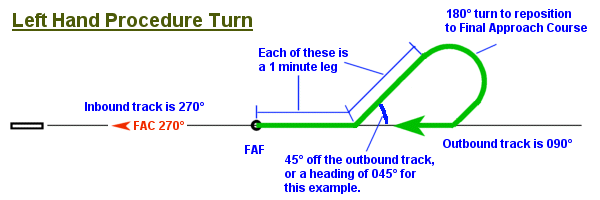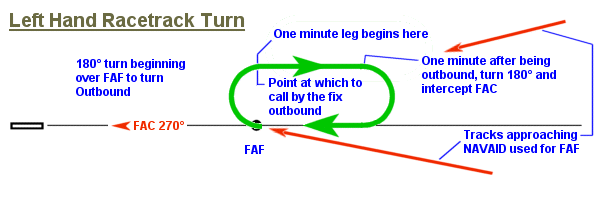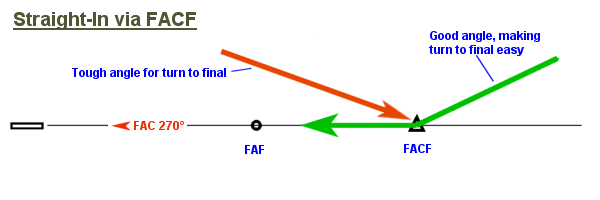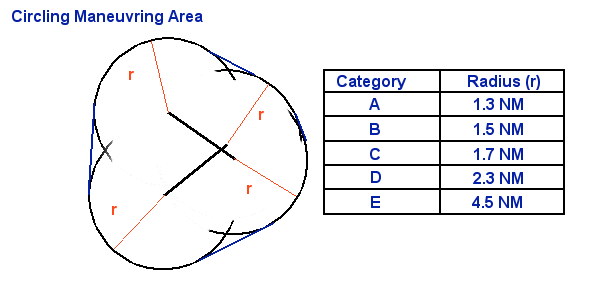
|
|
|
|
|
This week's topic:
IFR Flight Part 5d: Approach Clearance
In the past few weeks, we've delved into the world of Canadian aviation publications and looked at the Canada Air Pilot, or CAP. In this process, we've visited the neighbourhoods of the all important approach plate and the RNAV STARs to get you there. What if you're not flying a STAR? Or if one isn't published? We'll take a look now at the ATC approach clearance and some finer points of wording here. The Aeronautical Information Manual, or AIM, RAC 9.3, is one of our primary references here, though I don't intend to talk about uncontrolled airspace in this part.
Approach Clearance by NameIf ATC expects a pilot to fly a particular Instrument Approach Procedure (IAP), the controller must identify the procedure to be flown when issuing an approach clearance to a pilot. As mentioned in previous topics, the procedure name is to be spoken as it is named on the approach plate in the Canada Air Pilot (CAP) publication. If an IAP is named "ILS RWY 36", the clearance should contain the name spoken as "I-L-S Runway Three Six" and the word "Approach". Once the pilot reads the clearance back, it must be complied with as the readback indicates acceptance. As always, if the pilot cannot fly that procedure (because of issues related to equipment or anything else), the pilot may refuse the clearance and request something else, perhaps a clearance for a different IAP.
As mentioned above, if a pilot is expected or required to adhere to a particular IAP, the procedure must be named in the approach clearance. If no traffic makes adherance to a particular approach procedure important, the controller may issue a clearance "for an approach", which permits the pilot to fly any published instrument approach procedure for the destination airport. Some phraseology examples include:
Similarly, if a particular transition is to be used, a reference to that transition must be stated either leading up to the issuance of an approach clearance, or with the approach clearance itself. Transitions may be RNAV Initial Approach Segments, straight-in approaches via published fixes, or those published from nearby NAVAIDs. These are all discussed in previous topics, so please have a look for those in the event that you do not understand what is being referred to in this paragraph as a "transition". Some examples include:
The procedure turn is a manoeuver designed to align the aircraft onto the final approach course, and normally uses a ground-based NAVAID. The NAVAID can be a facility located somewhere on the final approach course, in which case the turn will be flown using the NAVAID itself as a reference point. It could also be located on the field, or even at a distance on the other side of the airport. In such a case, the final approach fix will normally be a fix determined by, for example, a VOR radial and a DME, or a VOR radial and a bearing from an NDB or other such combination of courses and distances.
It's worth noting that many IAPs do not have procedure turns published, even if based on a traditional ground-based NAVAID. Sometimes it's simply that the PT is never used, so maintaining this as part of the procedure is unnecessarily time consuming (it must be reviewed for any new obstacles such as new towers, and so forth). RNAV-based IAPs do not require PTs since an aircraft capable of point-to-point navigation, as would be required for flying such a procedure, doesn't require such a manoeuver to be flown to get the aircraft on the FAC.
The turn itself is not unlike a hold, as entry into the procedure turn has a few legitimate ways of being done. The traditional method of entry is accomplished by overflying the NAVAID and proceeding "outbound" over the fix. This simply means flying over or past the facility and further away from the airport. This outbound track is normally the reciprocal of the inbound track, or final approach course for the approach procedure.
Once by the facility outbound, the pilot should begin timing the procedure turn. A descent may be commenced to the procedure turn altitude depicted in the profile view on the approach plate, unless specifically restricted by ATC in the approach clearance. Normally, one minute after passing the fix outbound, a turn would be made 45° to the left or right as detailed in the approach plate, and the time noted again. The pilot would fly on this heading for 1 minute, then turn opposite to the direction turned to reach this heading, making the new course 180° from the previous. This heading should be flown until intercepting the final approach course. Once on the final approach course, the pilot now completes the approach procedure as detailed. Have a look below. The diagram will describe it much better than I just did.

From here, the pilot can use the procedure turn altitude as published as a minimum altitude, once established outbound, for descent while manoeuvring this way. This type of turn is also used when previously holding over the FAF waiting for an approach to transition once the approach clearance is finally received. It's interesting to note, as with holds, that the outbound report must only be given once the aircraft is over the facility or "abeam" it and established on the outbound track. "Abeam" means the facility is 90° to the left of the right of the aircraft as it passes. Many pilots in the real world have been reporting "over the fix outbound" while overhead the fix or NAVAID but before even commencing the turn to go outbound. The problem is that ATC may be clearing a departure out to an altitude below you, and may have restricted you to an altitude, for example by saying, "not below 4,000 til by the VOR outbound". If you were to start descending below 4,000 while still pointing at the airport, you are actually violating a clearance and could be jeopardizing separation. See the diagram below:

The image is labeled, somewhat inappropriately, "Left Hand Racetrack Turn" when all turns are made to the right. You'd be right in calling me out on this. It was labeled "left" to match the "Left Hand Procedure Turn" example above it as a continuance of the same example -- both manoeuvers are appropriate for a "PT Left". My naming of this is probably non-standard, but the drawn images defining how a pilot should manoeuver are appropriate.
As demonstrated in the IFR Charts Part 1 CAP, Subpart B Approach Plates, I mentioned the existence of published transitions. There are many ways that these can be published, so I'll leave you to read that article if you missed it, and perhaps even to review some approach plates on your own to see how these can be drawn. Typically, the transition is published from an en route facility, course or fix to a NAVAID from where a procedure turn or, more commonly, straight-in transition to final can be accomplished.
In the name of efficiency, something had to be done about those procedure turns. They can be time consuming and therefore costly for aircraft operators. Also, the time it takes an aircraft to manoeuver in a procedure turn can hold up subsequent arrivals, thereby compounding delays. The solution? A straight-in procedure allowing the pilot to manoeuver directly onto the final approach course without such a manoeuver. Other than an STAR, there are a few basic types of transitions that may be published.
The first type of straight-in transition I'll mention is going by the wayside, but I'll state it anyway since they do exist in some places: the DME arc. Typically drawn from VOR radials making up VHF airways, these are drawn to have the pilot intercept the published arc and track around the arc to the final approach course. When the pilot reaches the published "lead radial" or "lead course", the aircraft should begin the turn to intercept and track the final approach course, whether it's a localizer, an NDB track, a VOR radial, etc. To accomplish the DME arc transition, the pilot may need dual VOR receivers (one for the VOR/DME, and one for the localizer of an ILS, for example), except in certain cases, like a VOR/DME approach where it is normally based on the one NAVAID.
At many airports, ICAO Five-Letter Name Code (5LNC) fixes have been established on the final approach course to mark the beginning of the Intermediate Approach Segment. These allow aircraft with RNAV to navigate directly to this kind of fix, called an Intermdiate Fix, Intermediate Waypoint (for RNAV procedures) or Final Approach Course Fix, and then immediately join the final approach course. These fixes are established on the final approach course at a distance specified by design criteria and are typically approximately the distance specified in the profile view for completion of the procedure turn, where one is published. One complication of this is felt when the aircraft approaches from a difficult angle. See the diagram below:

As RNAV advanced throughout the world, approach procedures were designed to make use of the capabilities. This led to the "RNAV T" that is so common today. The tracks that make up the base legs of the design are referred to as initial approach segments, and the entry points are called Initial Approach Waypoints (IAWP).
Further leveraging the RNAV's capabilities, many IAPs that use ground-based NAVAIDs like ILS have been redesigned to include RNAV initials. These are often labeled "GNSS Required" indicating that satellite navigation is required in order for a pilot to make use of them. Such initial approach segments allow an RNAV-equipped aircraft to self-navigate all the way to final from virtually any direction, just as with an IAP based only on RNAV.
For years, especially in terminal environments, the normal mode of operation where radar coverage permits has been for ATC to vector an aircraft to final. I think most pilots of VatSim and Flight Simulator are familiar with this. ATC issues headings for the pilot to fly, which take into consideration winds that drift the aircraft, to direct the pilot to the final approach course. In Canada, ATC has had the following rules as standard practices:
When ATC issues an approach clearance, the pilot is to maintain the last assigned altitude until reaching the final approach course. Once confirmed on the FAC, the pilot may initiate a descent according to the published information on the approach plate that corresponds with the approach clearance issued by ATC.
Exceptions to these rules exist, too. Under certain weather conditions, ATC may vector the aircraft closer to the runway, but no closer to than the final approach fix, provided the pilot is informed this will be done, first. The pilot is not obligated to accept this, and may ask for something else, should this be undesirable for any reason. Note that it may mean being pulled out of the sequence and vectored around again if a lot of traffic is in close. A pilot may also request a vector to join closer than the normal 2 NM.
Something to note is that Minimum Radar Vectoring Altitudes are often lower than published minimum IFR altitudes for the surrounding airspace. This is usually because of the areas taken into consideration when designing the MRVA are different from, say, the 25 NM safe altitudes. MRVAs are not normally published for pilot reference. Also, cold weather altimeter corrections are not to be applied to altitudes assigned by ATC when an aircraft is in vectors from a controller -- those corrections are included in the MRVA since there is no way for a pilot to be certain where the altitude applies, such as would be the case on a published altitude for an approach or airway segment.
If a pilot on a radar vector notices a communication failure and is unable to contact ATC, that pilot is required to establish what airspace the aircraft is in and climb, if necessary, to an appropriate, published IFR altitude. The pilot is then to proceed to the final approach course via the most appropriate means available -- dead reckoning, if required -- and carry out the approach that ATC informed the pilot the aircraft was being vectored for. For example, if ATC says, "fly heading 090, vectors ILS RWY 23", the pilot is to navigate to the localizer and complete the ILS RWY 23 approach by the best means available. This makes the squawk of 7600 important with a comm failure, as this will be ATC's signal to get everyone else out of the way.
Sometimes it is desirable to complete an approach for one runway, and land on a different one. Sometimes that's the only option. CYSJ, Saint John, NB, has an ILS on RWY 05, and an ILS on RWY 23, but if the crosswinds are beyond the aircraft's or pilot's limitations, RWY 14/32 is available for landing. The trouble is that it has no ground-based instrument approach aid. In such a case, a pilot may request a clearance for a circling procedure. Note that pilot must not conduct a circling procedure without authorization from ATC as it may affect separation with other aircraft.
A pilot flying a circling procedure must fly the approach procedure identified in the clearance (if one is stated) until the aircraft is close enough to initiate the circling. How close? It depends upon the aircraft's category, which is in turn dependent upon the aircraft's speed on final. Below is a chart that shows the permitted circling area. It is derived from a radius from each of the airport's useable runways at a specified distance from the thresholds, all joined by tangent lines. The radius is defined by aircraft category.

One more note about circling procedures: If the pilot must do a missed approach, due to traffic, weather, whatever, the published missed approach instructions for the instrument approach procedure just completed apply, not the instructions for an approach procedure on the runway on which the landing was planned. Obstacle and terrain clearance remain the pilot's responsibility so the pilot must be careful when manoeuvering to ensure a climb is conucted in a safe area to the minimum IFR altitude.
If traffic is light, ATC may allow the pilot the flexibility of performing any approach desired. Such a clearance will sound something like, "... cleared to the Charlottetown Airport for an approach." In Canada, upon acknowledgment of receipt of such a clearance (ie, a readback), the pilot has the authority to descend to the minimum IFR altitude, to set up for any published instrument approach procedure via any published transition, and shoot that approach. The italics were placed there for a reason: The pilot may not, without explicit approval from ATC, fly a contact or a visual approach (See this topic on those).
One part of such a clearance is that the pilot is required to inform ATC as soon as practicable after receipt of such a clearance what approach is intended and what transition is to be used. Once it is stated, the pilot is expected to stick to the approach unless a later request is made for approval for another approach. For the purposes of determining a Minimum IFR Altitude, I'd like to refer you back to a previous topic, IFR Altitudes: Cruise and Descent.
Pilots are also responsible for keeping clear of restricted airspace, as well as compliance with noise abatement procedures and any other published flight restrictions.
This concludes our brief look at approach clearances. Any questions or comments, positive or negative feedback, whatever, please send it to me via e-mail to mo@xlii.ca. I'm always willing to accept praise or criticism about the work provided here. Thanks!